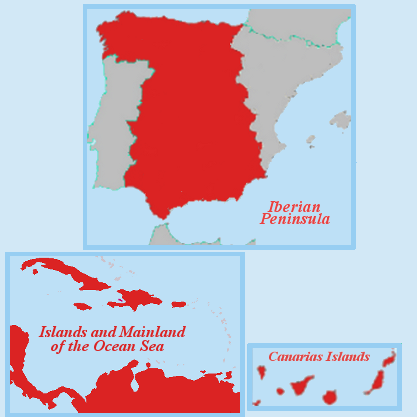Treaty of Villafáfila on:
[Wikipedia]
[Google]
[Amazon]
 The Treaty of Villafáfila is a treaty signed by
The Treaty of Villafáfila is a treaty signed by
Ferdinand the Catholic
Ferdinand II ( an, Ferrando; ca, Ferran; eu, Errando; it, Ferdinando; la, Ferdinandus; es, Fernando; 10 March 1452 – 23 January 1516), also called Ferdinand the Catholic (Spanish: ''el Católico''), was King of Aragon and Sardinia from ...
in Villafáfila
Villafáfila is a municipality located in the province of Zamora, Castile and León, Spain. According to the 2004 census (INE
INE, Ine or ine may refer to:
Institutions
* Institut für Nukleare Entsorgung, a German nuclear research center
* ...
on 27 June 1506 and by Philip the Handsome
Philip the Handsome, es, Felipe, french: Philippe, nl, Filips (22 July 1478 – 25 September 1506), also called the Fair, was ruler of the Burgundian Netherlands and titular Duke of Burgundy from 1482 to 1506, as well as the first Habsburg Ki ...
in Benavente, Zamora
Benavente is a town and municipality in the north of the province of Zamora , in the autonomous community Castile and León of Spain. It has about 20,000 inhabitants.
Located north of the capital on an important communications hub, it was repo ...
, on 28 June.
The treaty recognised the incapacity of Ferdinand's daughter and Philip's wife, Joanna the Mad
Joanna (6 November 1479 – 12 April 1555), historically known as Joanna the Mad ( es, link=no, Juana la Loca), was the nominal Queen of Castile from 1504 and Queen of Aragon from 1516 to her death in 1555. She was married by arrangement to Phi ...
, to reign on her own as Queen of Castile, while allowing her to keep the royal title. Joanna had succeeded her mother, Isabella the Catholic, who had appointed her husband and co-ruler Ferdinand as regent of Castile in the name of their mentally unstable daughter. However, Philip demanded his share in the government. The Treaty of Villafáfila followed the Treaty of Salamanca (24 November 1505), in which Ferdinand and Philip were recognised as co-regents in Joanna's name. However, the new treaty required Ferdinand to cede all power to Philip and retire to his own hereditary realms, the Crown of Aragon
The Crown of Aragon ( , ) an, Corona d'Aragón ; ca, Corona d'Aragó, , , ; es, Corona de Aragón ; la, Corona Aragonum . was a composite monarchy ruled by one king, originated by the dynastic union of the Kingdom of Aragon and the County of ...
, to which Joanna was also heir presumptive
An heir presumptive is the person entitled to inherit a throne, peerage, or other hereditary honour, but whose position can be displaced by the birth of an heir apparent or a new heir presumptive with a better claim to the position in question.
...
, and proclaimed Philip jure uxoris King of Castile
This is a list of kings and queens of the Kingdom and Crown of Castile. For their predecessors, see List of Castilian counts.
Kings and Queens of Castile
Jiménez dynasty
House of Ivrea
The following dynasts are descendants, in the ...
. Ferdinand renounced not only the government of Castile, but also the lordship of the Indies, leaving a half of the income of the kingdoms of the Indies. Joanna and Philip immediately added to their titles of "Kings of Indies, Islands and Mainland of the Ocean Sea".
The treaty was made moot very soon, since King Philip I died on 25 September. After a brief regency of Cardinal Cisneros
Cardinal or The Cardinal may refer to:
Animals
* Cardinal (bird) or Cardinalidae, a family of North and South American birds
**'' Cardinalis'', genus of cardinal in the family Cardinalidae
**''Cardinalis cardinalis'', or northern cardinal, t ...
, Ferdinand assumed the government of Castile in August 1507, returning to the regency of the crown and recovering the title of lordship of the Indies, both of which he held until his death in 1516, with Joanna confined at Tordesillas
Tordesillas () is a town and municipality in the province of Valladolid, Castile and León, central Spain. It is located southwest of the provincial capital, Valladolid at an elevation of . The population was c. 9,000 .
The town is located ...
.
The Indies remained in an ambiguous state from the death of Philip in 1506 to the death of Ferdinand in 1516, being half a personal property of the kings (a "lordship" with absolute power for its lord), and half a kingdom of the Crown (ruled under the laws of the Crown of Castile). The thrones of Aragon and Castile passed to Joanna and her son Charles I, the later Charles V, Holy Roman Emperor, as co-monarchs, but with Joanna kept under confinement, Charles was the sole effective ruler. From 1516 to 1520 the Indies were extraofficially part of the Crown of Castile. On July 9, 1520 Emperor Charles V incorporated them explicitly into the Crown of Castile and he forbid any future separation.
References
* {{DEFAULTSORT:Treaty of Villafafila Treaties of the Crown of Castile 1506 in Spain 1506 in law